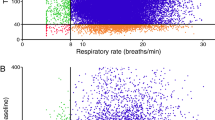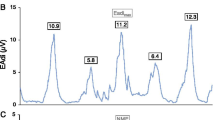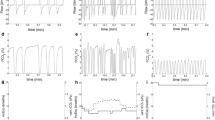Summary and Conclusions
We have made serial measurements of CT, CL, and A-aDo2 during anaesthesia with controlled ventilation in 27 patients undergoing surgical procedures not involving the thorax or abdomen. These patients were divided into three groups, according to the technique of controlled ventilation: group 1, Bird, no sighs; group 2, Bird with sighs; and group 3, Engstrõm, no sighs.
We found generally low values for CT and CL and abnormally wide values for A-aDo2, and these were not reversed by hyperinflation. However, the patients who were sighed did maintain higher CL than did patients on the same ventilator who were not sighed. Values for A-aDo2, however, were not consistently lower in the sighed group. In addition, CL was higher in patients on the Engström, than in patients on the Bird, no sighs being given to either group. In spite of this, the Engström did not prove to be a more effective respirator, since A-aDo2 widened to the same degree with both ventilators. In other words, our data suggest that pulmonary mechanics decline less if sighs are given, and if the Engström ventilator rather than the Bird is employed, but that these advantages in terms of mechanical properties are not accompanied by better gas exchange.
This study has not a ready explanation for the low compliance values and the high values for A-aDo2 found by us and by others1–3, 17 during anaesthesia.
Résumé
Au cours de l’anesthésie, chez 27 malades en ventilation controlée subissant des opérations n’impliquant ni le thorax, ni l’abdomen, nous avons mesuré en série le CT, le CL et l’A-aDo2. Nous avons divisé ces malades en trois groupes selon la technique de la ventilation controlée: le groupe 1, le Bird sans soupirs; le groupe 2, le Bird avec soupirs; le groupe 3, l’Engström sans soupirs.
De façon générale nous avons trouvé des valeurs basses pour CT et CL et des écarts anormaux des valeurs pour A-aDo2 et elles n’ont pas été modifiées par la surdistension. Toutefois, les malades à qui Ton faisait des soupirs ont conservé un CL plus élevé que ne l’ont fait les autres malades sous le même ventilateur sans soupirs. Les valeurs pour l’A-aDo2 cependant n’ont pas été diminuées de façon constante chez ceux à qui Ton faisait des soupirs. De plus, chez les malades sous Engström, le CL était plus élevé que chez les malades sous le Bird; aucun n’avait eu de soupirs. Malgré cela, l’Engström ne s’est pas avéré un respirateur plus efficace; l’écart de A-aDo2 a été le même avec les deux ventilateurs. En d’autres termes, nos données nous font croire que la mécanique pulmonaire diminue moins si Ton pratique des soupirs et si Ton emploie l’Engström plutôt que le Bird, mais ces avantages, en terme de propriétés mécaniques, ne s’accompagnent pas de meilleurs échanges gazeux.
Cette étude ne permet pas de fournir une explication pour les basses données de la compliance et les données élevées de l’A-aDo2 que d’autres auteurs et nous avons trouvé durant l’anesthésie.
Similar content being viewed by others
References
Bendixen, H. H., Hedley-Whyte, J.; &Laver, M. B. Impaired Oxygenation in Surgical Patients during General Anaesthesia with Controlled Ventilation. New England J. Med.269: 991 (1963).
Nunn, J. F.;Bergman, N. A.; &Coleman, A. J. Factors Influencing the Arterial Oxygen Tension during Anaesthesia with Artificial Ventilation. Brit. J. Anaesth.37: 898 (1965).
Panday, J. &Nunn, J. F. Failure to Demonstrate Progressive Falls of Arterial Po2 during Anaesthesia. Anaesthesia.23: 38 (1968).
Fairley, H. B. &Hunter, D. D. The Performance of Respirators Used in the Treatment of Respiratory Insufficiency. C.M.A.J.90: 1397 (1964).
Van Bergen, F. H. The Mechanical Lung Ventilator as Another “Black Box.” Canad. Anaesth. Soc. J.14: 159 (1967).
Gilbert, R. G. B.;Brindle, G. F.; &Galindo, A. Anaesthesia for Neurosurgexy. Boston: Little, Brown (1966).
Nunn, J. F. Indirect Determination of the Ideal Alveolar Oxygen Tension during and after Nitrous Oxide Anaesthesia. Brit. J. Anaesth.35: 8 (1963).
Severinghaus, J. Methods of Measurement of Blood and Gas CO2 during Anesthesia. Anesthesiology.21: 717 (1960).
Haldane, J. B.;Meakins, J. C.; &Priestley, J. G. The Effects of Shallow Breathing. J. Physiol.52: 433 (1919).
Mead, J. &Collier, C. Relation of Volume History of Lungs to Respiratory Mechanics in Anaesthetized Dogs. J. Appl. Physiol.14: 669 (1959).
Ferris, B. G. Jr. &Pollard, D. S. Effect of Deep and Quiet Breathing on Pulmonary Compliance in Man. J. Clin. Invest.39: 143 (1960).
Fairley, H. B.;Kerr, J. H.;Laws, A. K.; &Sellery, G. R. The Avoidance of Postoperative Hypoxaemia: An Assessment of Three Techniques for Use during Anaesthesia. Canad. Anaesth. Soc. J.15: 152 (1968).
Griffo, Z. J. &Roos, A. Effect of O2 Breathing on Pulmonary Compliance. J. Appl. Physiol.17: 233 (1962).
Agostoni, E. &Mead, J. Statics of the Respiratory System. Chap. 13, Handbook of Physiology: Respiration I. Washington: American Physiological Society (1964).
Egbert, L. D.;Laver, M. B.; &Bendixen, H. H. Intermittent Deep Breaths and Compliance during Anesthesia in Man. Anesthesiology.24: 57 (1963).
Bromage, P. Total Respiratory Compliance in Anaesthetised Subjects and Modifications Produced by Noxious Stimuli. Clin. Sc.17: 212 (1958).
Gold, M. I. &Helrich, M. Pulmonary Compliance during Anesthesia. Anesthesiology.26: 281 (1965).
Rahn, H. &Fahri, L. E. Ventilation, Perfusion and Gas Exchange - the\(\dot VA/\dot Q\) Concept. Chap. 30 in Handbook of Physiology: Respiration I. Washington: American Physiological Society (1964).
Cole, R. B. &Bishop, J. M. Variation in Alveolar-Arterial O2 Tension Difference at High Levels of Alveolar O2 Tension. J. Appl. Physiol.22: 685 (1967).
Safar, P. Respiratory Therapy. Philadelphia: F. A. Davis (1965), p. 105.
Radford, E. P.;Ferris, B. G.; &Kriete, B. C. Clinical Use of a Nomogram to Estimate Proper Ventilation during Artificial Respiration. New England J. Med.251: 877 (1954).
Author information
Authors and Affiliations
Additional information
This study has been supported by grants from the Medical Research Council of Canada and the John A. Hartford Foundation, U.S.A. It was submitted as part of Dr. Cocco’s thesis for the degree of M.Sc. (Experimental Medicine), McGill University.
Rights and permissions
About this article
Cite this article
Douglas, F.G.V., Cocco, J., Becklake, M.R. et al. Pulmonary mechanics and gas exchange during neurosurgical anaesthesia. Can. Anaes. Soc. J. 16, 7–17 (1969). https://doi.org/10.1007/BF03005773
Published:
Issue Date:
DOI: https://doi.org/10.1007/BF03005773




